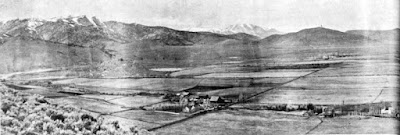In my recently published book, Clara, at the time my pioneer families that traveled together in 1858 finally stopped, they ended up settling in Eagle Valley, Utah Territory.
Originally inhabited by the indigenous Washoe people, it is believed in 1841 the Bartleson-Bidwell Party passed through the area that became known as Eagle Valley on their way to California.
 |
| Augustus Mitchell Map of 1846 |
At the time, California was still part of Mexico. In the mid-1840s, while the land was still under Mexican rule, John C. Frémont traveled through as part of a mapping expedition.
_in_Dayton,_Nevada.jpg) |
| Carson River |
Because of his great respect for his scout, Kit Carson, he named the river running through that valley the Carson River. In 1848, at the conclusion of the Mexican-American War, Mexico ceded the region to the United States. That was the same year gold was discovered in California. That resulted in a stream of gold-seekers traveling west to search for their fortunes.
Many of them followed the Mormon-Carson Emigrant Trail cut by the Mormons, who had arrived in California by way of the Mormon Battalion or on the ship Brooklyn, as they traveled east. Their trail took them past what is today Caples Lake, over Carson Pass, and through Eagle Valley until they joined with the established trail that followed the Humboldt River.
 |
| 1857 map Utah Territory |
In September 1850, Eagle Valley became part of the newly established Utah Territory.
 |
| Old Mormon Station built 1851 |
Many early valley settlers included other Mormons, led
by Colonel John Reese who, in 1851, along with eighteen men, established Mormon
Station (name later changed to Genoa) near the valley. This was the first
trading post in the far western part of Utah Territory. After the Mormons were called
back to Salt Lake City, the local ranchers in the valley established another
trading post called Eagle Station. It is believed the
post was located near present-day Fifth and Thompson streets in Carson City. It
provided supplies to those California-bound travelers who chose to take the
Mormon-Carson Emigrant branch of the California Trail over Carson Pass to
Placerville and the gold fields of the western Sierra Nevada Mountain
foothills.
The surrounding area was known as Eagle Ranch. The name reportedly came from an eagle shot by ranch manager Frank Hall, who displayed it on the trading post wall. That gave the name to the valley.
%20Libri30.jpg) |
| Carson City today, most of city is in Eagle Valley |
In 1858, pioneer Abraham Curry arrived in Eagle Valley and not long afterward surveyed and plotted a town site. A group of well-connected attorneys bought the richest part of the valley for $500 and a herd of horses. The farsighted and optimistic Curry set aside 10 acres expressly for the construction of a capitol building. He anticipated the formation of Nevada Territory, which did not take place until 1861. Carson City was soon designated both the territorial capital and county seat of the new Ormsby County.
 |
| 1912 Eagle Valley looking northeast |
 | |
|
%20libri30.jpg) |
| Carson City in Eagle Valley looking west across Carson Mountains toward Lake Tahoe |
The 1859 discovery of the Comstock Lode in the Virginia Mountains to the east and north of Carson City established the economic importance of the area.
In Clara, my characters chose to travel beyond the new city of Carson City and Eagle Station and settle in the town of Genoa. This book is now available for purchase as an ebook and paperback. It is also available at no extra cost with a Kindle Unlimited subscription. To find the book description and purchase options, please CLICK HERE.
Also, although each book can be read as a standalone, my first book I wrote for the Prairie Roses Collection, Pearl, has many of the same characters as Clara. To find the book description and purchase options, please CLICK HERE.
Sources:
https://en.wikipedia.org/wiki/Eagle_Valley_(Nevada)
http://en.wikipedia.org/wiki/Wikipedia:Text_of_Creative_Commons_...
Ken Lund from Reno, Nevada, USA
https://wnhpc.com/details/rw014
https://photos.legendsofamerica.com/nv-southern/h83F9897F#h83f9897f






No comments:
Post a Comment